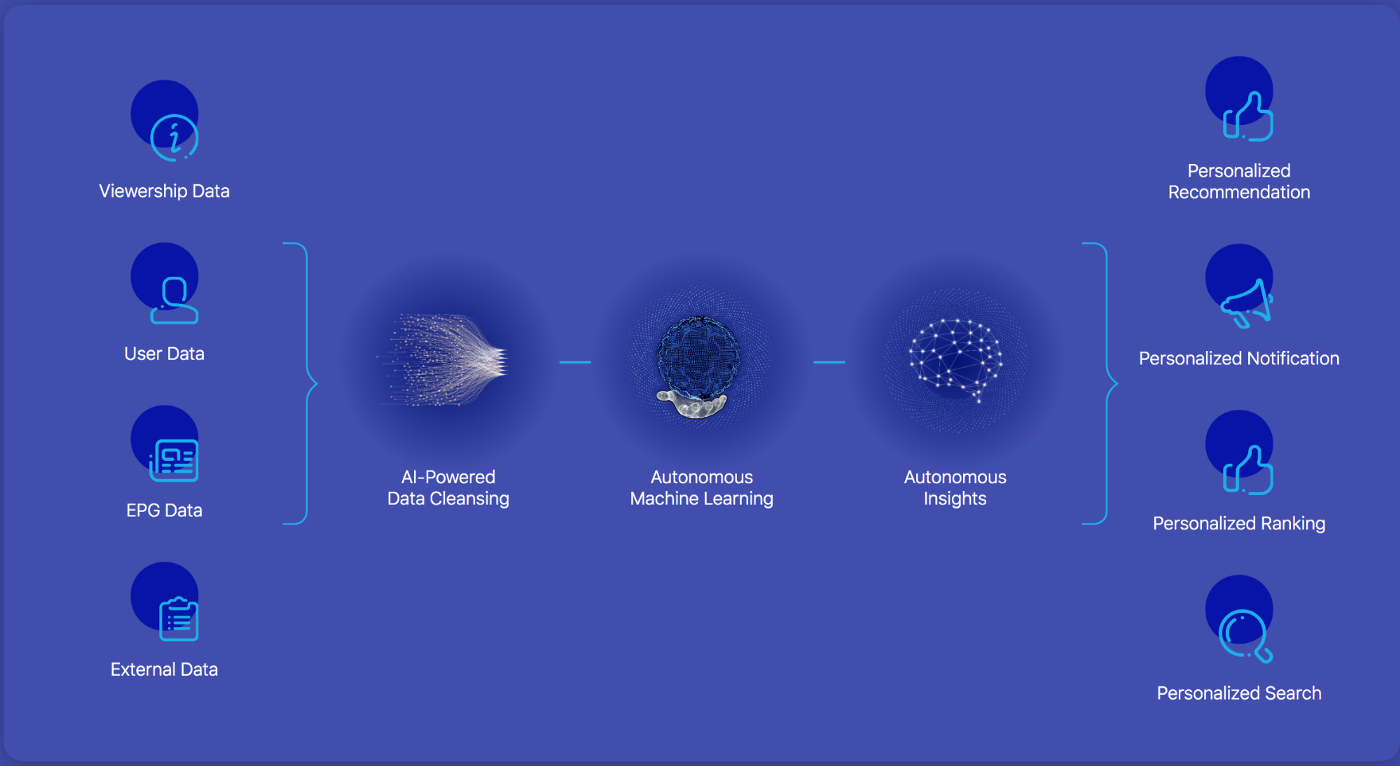How can better Search and Recommendation help retain User Engagement and mitigate User Churn in an increasingly dynamic media landscape?
Video on Demand services has mushroomed in popularity with many popular television and DTH service providers bringing their content to major streaming platforms. The shift from traditional TV to digital media is quite the norm, with most channel partners announcing a roadmap for digital platforms and video-on-demand services. [1]
Users now have more to choose from than ever. As choice increases, streaming platforms and content discovery platforms have to balance costs with an ever-growing pedantic set of users. Add to that the relative ease of cancellations, and retaining customers can seem like surmounting a millennium conquest.
However, with the right approach to platform design and structure, a platform can mortise user experience with design to achieve a high degree of user retention and loyalty.
What is User Churn?
User churn is simply the turnover of users on a platform or the loss of subscriptions for SaaS platforms. Traditionally, user churn is representative of angry calls or emails for membership cancellations and refunds.
Presently though, with the move to the web and portable devices, user churn has more to do with a prolonged lack of user interaction with the service than with actual cancellations. Also, most new video platforms, in their quest for user adoption, may offer ‘free-trials’, where user interaction may be the only metric of user retention and engagement, rather than a loss of subscriptions.
Why do Users Churn?
Streaming services have become more and more affordable as time has gone by. This cost-benefit has allowed them to focus more on bringing content to the user.
However, streaming services have huge catalogs. Inherently, users only discover a small part of this catalog. Hence, this becomes not a problem of quantity but that of quality and visibility.
A platform needs to figure out what type of content a user is most likely to enjoy. A service that presents its users with content they do not like is likely to cause user disengagement. Subsequently, users may switch services in hopes of more relevant content.
Impact of Search and Recommendation on User Churn
A streaming service is reliant on algorithms that suggest content to users. Non-personalized search and recommendation system that does not take user preferences or user behavior into account are more likely to serve content that the user does not enjoy and could lead to user churn. [2]
Search

Before users start watching a video, they still have one last step. They need to find the right show. And, the best way to do that is to search for the show. However, most users may not always remember the name of a show and may search for it by the cast, age, a dialogue from the movie, or even filter by producers in some strange cases. A search that only filters by names or keywords may return very irrelevant results, or none at all.
Lack of relevant search results is most likely to prevent the user from using the platform and cause a switch for better content.
Recommendations

Video recommendation engines are content discovery platforms that are inconspicuous agents of burgeoning serendipity. They lead users on to content they may enjoy, acting as legates of content discovery. On the flip side, recommendation engines wield an enormous level of control and can be one of the primary reasons users may not find the content of interest. In that, a recommendation engine that does not account for every feature is one that may fail to find content that bedazzles the user amd i,proves user retention in OTT.
Streaming Experience
Platforms that have search and recommendation algorithms can only bring users to the video page. User experience is the next step and also key to user retention. A platform’s user experience is an amalgamation of user interface design, content discovery, video streaming quality, and streaming performance. A video that takes too long to buffer or refuses to load or a user interface that does not have proper buttons and intuitive navigation will cause users to wait too long for their subscribed content. Users may then switch services out of impatience.
How to Prevent Churn?
User churn is often one of the most underestimated metrics in consumer analytics. Businesses often fail to identify user churn until it is too late. By then, they may have already lost a swathe of their user-base. Also, platforms, when faced with regression of user subscriptions, redouble their efforts on user acquisition. However, user on-boarding can be quite a lot more expensive and less rewarding than maintaining the loyalty of their existing users.
Data Acquisition for Consumer Analytics and Experimentation
Businesses need to analyze their offerings for deficiencies. The best way to analyze user data is to measure user engagement through predefined metrics, such as setting key-point indicators (KPIs) and user-engagement goals. Businesses can retain users effectively only if they understand their users well, and the first step is data acquisition for quantifying user experience.
Session Data
The best way to understand a user is to map a user session and determine hotspots of user engagement on the platform, through video and user diagnostic data.
Streaming KPIs
Streaming key point indicators include watch-time, streaming quality, and performance. Watch-time is the cumulative duration of time a user’s browser requests video data. Servers may additionally keep logs of used bandwidth to measure the streaming quality of the video as well as to determine a user’s preferred resolution of streaming.
Also, platforms may include scripts that ping the host server to check for latency or maintain the time needed to cache video content. Such a script would allow servers to keep logs of errors and help measure streaming performance markers, such as buffering duration, rebuffering ratio, and used bandwidth.
User Journey and Event Maps
Every user interaction with their device, scrolls, hovers, and clicks on a page, generates events. A server can issue callback functions and requests against these events and effectively determine pages, sub-sections, and resources users have checked over a given time.
A user journey map effectively lays out user interactions in the form of a user narrative. — CXL — Heat Maps https://cxl.com/blog/heat-maps/ These tools measure user engagement since they can point out metrics such as percentage completion of streams, time spent hunting for content, and streaming delays.
Diagnostic Data
These are the diagnostic data that relate to servers and device-specific information such as device codec support, region, and data related to server load distribution. Diagnostic logs may additionally contain data about user agents, permissions, etc. These help determine the type of data that a server should send the user, as well as video encoding and compression needed.
How to use Data for Content Analytics
Services may use data that they collect from user interactions and diagnosis to measure the level of user engagement. Such diagnostic data needs to be processed and enriched before they can be of use for experimentation. Intelligent techniques for data pre-processing involve machine learning and artificial intelligence.
Using Data for Experimentation and Insights
Users on a streaming platform spend most of their time searching as well as browsing for content that aligns with their preferences. Most user journeys point out that users spend 60–90 seconds searching for relevant content before eventually leaving a platform.
A user’s ‘attention’ span is a valuable starting point for further experiments and evinces a heuristic for user engagement. Further, quasi and A/B experiments can use a catalog of machine learning models to conduct parallel experiments and determine search and recommendation models that best serve relevant and engaging content.
A/B Tests
A/B Tests are randomized tests that run a combination of recommendation or search models to determine the model that best serves a user content of her interest in the best possible time. These tests demarcate control and experimental groups and run tests either in batch or real-time modes. Such tests are versatile and can run in parallel for different models. Given a catalog of models, a system can run tests on various parts of a user interface, such as artwork, thumbnails, and metadata. Algorithms can control the parameters of experiments to extract more in-depth statistics on user engagement.
A streaming service that wants to find the best rank of thumbnails and artwork on a forward-facing page may run permutations of several forward-facing user interfaces and find the arrangement that ensures the user makes the best decision in the shortest time.
Such tests help services use the best algorithms that are backed by rigorous testing, which takes the guesswork out of redesign and restructuring. [3]
Quasi Experimentation
Quasi Experiments are an alternative to A/B Testing, where the system may find it infeasible to run individual tests. Often, simple A/B tests may fail to prevent interference between test cases in a randomized trial.
For example, simple A/B tests may fail to distinguish between user engagement due to in-platform recommendations and external marketing efforts. A quasi-experiment helps remove external bias in these cases. A quasi-experiment will not randomize individuals for a test but instead assign users based on pre-emptive indicators, such as location and time. This way, the tests may look at historical data to determine expected patterns and extract only relevant results from experiments. [4]
Quasi-experiments lack the propensity for randomness. Hence, here the system selects a control group that has similar indicators to the test group, differing only in the level of exposure to the experiment. The system then observes differences in user behavior and engagement. [4], [5]
How Can Argoid Analytics Help Measure and Mitigate User Churn?
Search, recommendation, and testing is the backbone of every streaming platform. Recommendation models power algorithms that provide the most engaging user interfaces and content of their interest. Argoid Analytics provides model catalogs, which, powered by their data curation techniques, extract most insights out of user interactions.

Using Argoid to Process Data
Platforms can take advantage of data pre-processing algorithms and Argoid’s Big Data Stack to provide data for efficient classification and grouping of users for intelligent group recommendations so that platforms never have to worry about cleaning every individual data point.
Using Argoid to Power Recommendations and Search
Argoid Analytics has a vast catalog of machine learning models and uses intelligent algorithms for content discovery to assign search and recommendation models for every use case. Argoid, thus provides the infrastructure to run large scale automated user experience tests so that services can gain almost real-time feedback on their content insights with zero downtime.
Visualization of Results using Dashboards
Argoid Analytics provides content discovery platforms with real-time monitoring of user interaction data and allows easy configuration through their interactive dashboard.
How Intelligent Content Discovery can Improve User Retention?
Streaming services need intelligent content discovery platforms and recommendation systems to serve users with relevant content. Additionally, a service that provides users with a consistent and intuitive browsing experience can ensure user satisfaction and loyalty. Streaming errors, delays, and bugs can spoil user engagement and cause users to obey subscriptions, and subsequently, user churn.
A streaming service can improve user engagement through data analytics. Data aquisition regarding user journeys, user histories, and streaming performance can provide observational data for user experience. Experiments and testing can ratify and further improve the effectiveness of recommendation algorithms and overall user interface design.
Argoid Analytics provides users with algorithms for recommendation engines and search algorithms, a big data stack for consumer analytics and insights, and highly customizable dashboards to monitor and configure experiments, measure performance ,tailor the best experience for the user and increase user retention in OTT. To know more, Talk to us!
FAQs on Content Discovery
What is intelligent content discovery?
Intelligent content discovery is about generating user-friendly content that meets the requirements of your target audiences improve the possibilities of user retention. Intelligent content discovery is all about reducing user churn with dynamic and personalized content.
Why digital streaming platforms should work on intelligent content discovery?
Digital streaming platforms should work on intelligent content discovery to ensure that users are receiving effective recommendations and the possibilities of user churn are declining.
How personalization influences content discovery?
Personalization has a positive impact on the content discovery process. With personalized content discovery, you can provide customers with the types of content they prefer and improve user retention.


.png)
.png)


